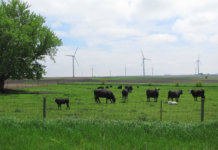On Monday, President Barack Obama and U.S. Environmental Protection Agency (EPA) Administrator Gina McCarthy announced the roll-out of the Clean Power Plan (CPP) imposing carbon dioxide (CO2) standards on existing power plants. Given the intent of reducing CO2 emissions by 17% below 2005 levels by 2022 and 26% to 28% below 2005 levels by 2025, these rules will have a significant impact on industrial consumers of electricity, as well as on developers of fossil-fuel-fired and renewable (e.g., solar, biomass and wind) generation.
Obama has repeatedly stated his determination to regulate the roughly 40% of the nation's greenhouse-gas (GHG) emissions that come from the energy sector. The EPA proposed rules on June 18, 2014, that would impose a complex program for regulating existing power plants. Monday's rule brings the first stage of this rulemaking closer to a conclusion. Although the most attention is on the rules applicable to existing power plants, rules for regulation of CO2 from new and modified facilities is traveling in lockstep with the existing source rules.
Section 111(d) differs from the EPA's conventional rulemaking authority. For new and modified power plants, the EPA simply issues standards (under CAA Section 111(b)) that are directly applicable to all new and modified affected facilities. The EPA proposed CO2 standards under CAA Section 111(b) for new power plants in January 2014 and for modified power plants in June 2014. The EPA's 111(d) authority is more circumspect. Rarely employed, Section 111(d) grants the agency the authority to issue emission guidelines that then must be used by the states to craft programs that are consistent with the EPA's stated objectives. These state programs must then be approved by the EPA. However, the guidelines are just that – options for how to create a program and not outright mandates as to what the state rules must entail. The EPA issued 111(d) standards for existing, unchanged power plants Monday that seek to establish a unique program unlike any other existing regulatory program.
The CPP establishes state-specific CO2 emission limits and requires that the states demonstrate how they will achieve those limits by the deadlines in 2022 and 2030. The concept of two-stage limits matches what was proposed in 2014. However, the EPA has extended the deadline for compliance with the initial standards from 2020 to 2022; the second-stage deadline remains unchanged at 2030. The CO2 limits are applicable to existing coal- and oil-fired power plants, as well as existing natural-gas-fired combined-cycle generating facilities – a change from the 2014 proposal.
In establishing its plan to comply with the 111(d) mandate, a state can choose to comply with one of three types of limits. First, and consistent with the 2014 proposal, a state can adopt a pound per megawatt-hour (lb/MWh) limit. Second, a state can adopt a total ton per year (tpy) CO2 cap that would apply within the state. This option was also discussed in the 2014 proposal, but no values were suggested for individual states. Third, a state can adopt a tpy CO2 cap that includes an allowance for new sources. Once the limit is established, a state must develop and implement a plan to achieve the limit. This plan can consist of either a conventional limit applicable to the electrical generating units covered by the CPP (i.e., coal- and oil-fired power plants and natural-gas-fired combined-cycle units), or it can reach "beyond the fence," incorporating other CO2 reductions and taking credit for those when calculating compliance. It is the utilization of these "beyond the fence" measures, such as renewable energy standards and residential energy efficiency programs, to demonstrate compliance with standards applicable to power plants that fostered a lot of questions in 2014 as to the legality of the program. The EPA is also requiring a hard "backstop" limit that will automatically kick in and apply to individual regulated electrical generating units if the state program fails to achieve its intended "beyond the fence" reductions.Â
The EPA is clearly trying to promote nationwide or regional cap-and-trade programs. The final rules promote emissions trading mechanisms and discuss the CPP enabling states to generate "trading ready" allowances that avoid the need for interstate agreements. Expanding on language in the 2014 proposal, the EPA speaks of individual power plants being able to meet their obligations through emission rate credits (if a rate-based standard is adopted) or allowances (if a mass-based standard is adopted). Cap-and-trade was a clear element underlying the 2014 proposed rule, but it takes on a more prominent role in the final rule.Â
Implementation of the program will take place over the next 15 years. As noted above, each state has a limit it must attain by 2022 and a more stringent limit by 2030. Many of these limits have changed dramatically from the 2014 proposal (e.g., the 2030 limit for Washington increased from 215 lbs CO2/MWh to 983 lbs CO2/MWh, while North Dakota decreased from 1,783 lbs CO2/MWh to 1,305 lbs CO2/MWh). Each state must develop a plan for how it will attain these limits that must be reviewed and approved by EPA. If a state fails to propose a plan or the EPA disapproves the state's plan, then the agency will impose requirements in that state. The initial submittals are due by Sept. 6, 2016. This initial submittal can consist of either a state's final plan or an initial plan with a request for an extension. By Sept. 6, 2018, all final plans must be submitted. These plans must identify milestones used to demonstrate progress toward achieving the CO2 reduction goals.Â
The rules create the Clean Energy Incentive Program (CEIP), which provides an interesting opportunity for renewable energy developers. The CEIP allows states a mechanism to reward wind and solar projects that commence construction after a state submits its 111(d) plan to the EPA (or after Sept. 6, 2018, for states that choose not to submit a final state 111(d) plan by that date).
A project must be either located in a state or benefit a specific state to be eligible under the CEIP as part of that state's 111(d) program. The states are required to include a CEIP implementation regimen in their 111(d) plan and account for allowances (if a mass-based plan approach) or emission rate credits (ERCs) if a rate-based plan approach. If the state does so and the wind or solar project commences construction after the state plan is submitted, then the project earns ERCs or allowances based on the quantity of metered megawatts generated in 2020 and 2021. Among renewables projects, only wind and solar are eligible. For every metered MWh generated in 2020 and 2021, the project will receive one ERC (half from the state and half from the EPA). Even states or tribal areas without any regulated generating units may provide ERCs so long as they are connected to the contiguous U.S. grid and meet certain eligibility requirements. The ERCs or allowances can be used for compliance by a regulated generating unit and are fully transferable prior to such use. A nationwide cap of 300 million tons of CO2 ERCs/allowances applies to the CEIP program (and includes ERCs/allowances awarded to low-income energy efficiency projects that reduce electricity usage in low-income communities in 2020 and/or 2021). In order to be eligible for the ERCs/allowances under the CEIP, developers are not required to demonstrate that their project is "additional" or surplus relative to a business-as-usual or state-goal-related baseline. Many questions abound about how the CEIP will work, and the EPA does not address them in Monday's rule. Instead, the agency plans to issue another rule with the details of the CEIP.Â
Stay tuned as this process unfolds in the next few days, weeks and years. The EPA's issuance of the rules shifts the burden to the states to develop plans and triggers further rulemaking to flesh out requirements like the CEIP. There will be opportunities to get involved in the federal rulemaking, as well as with state rulemaking efforts as the states navigate this maze of requirements and work to meet the tight deadlines.Â
Tom Wood is a partner at Stoel Rives LLP, where his practice focuses on the Clean Air Act.



